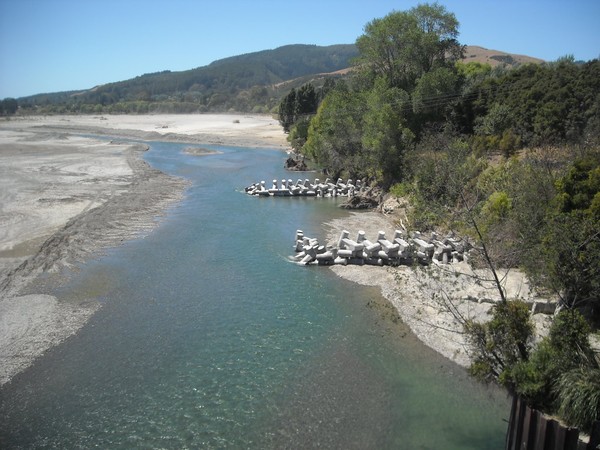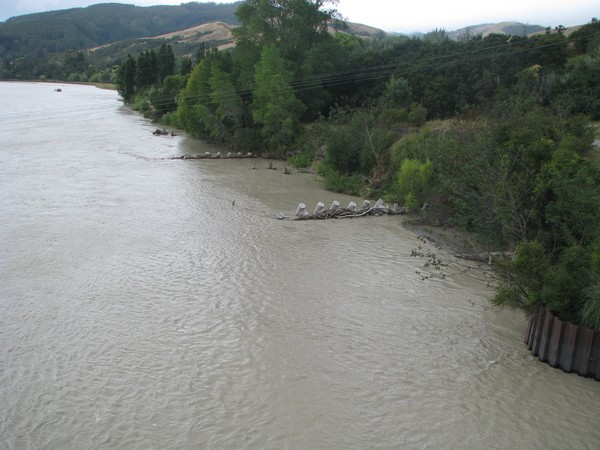World first to protect Ruatoria


The first steps to stop the Waiapu River threatening the Ruatoria Township were put in place last week.
Two groynes were placed downstream from the Rotokautuku Bridge. The purpose of the groynes is to encourage the Waiapu River to veer to the left bank where it used to flow before Cyclone Bola. The groynes are made up of 35–40 large concrete shapes called dolosse. Each weighs four and a half tonnes, is two and half metres long and nearly two metres wide and high. They have been manufactured on site by Ruatoria based contractor Ron Hedley Ltd. Local labour and shingle from the Waiapu River has been used to make the concrete. The shingle has been washed with a specially made cotraflow washer, designed by Mike Ross from local company Waiapu Metal/Rock products.
“We needed to wait until we had a good patch of dry weather so that the river levels were low,” says Gisborne District Council Rivers and Land Drainage Manager Jurgen Komp. “Last week was the perfect opportunity to get the groynes in before the cyclones hit over the weekend. CR Taylor’s crane was bought up from Gisborne to lower the dolosse down the bank. They were put in place by Tolaga Bay based Kimberley Contractors. The placing took two days and then a further day to tie the wire rope to each of the dolosse to help keep them in place. This was all finished just before the heavy rain hit.”
“I had a look at the groynes and they have held up well. Normally after that amount rain we would expect further erosion of the right bank. This hasn’t happened and in fact we can already see the groynes making a difference to the way the river is flowing. A small diversion is starting to form.”
“The Waiapu River used to flow quite steadily along the left bank for many years before Cyclone Bola. Cyclone Bola cut a channel on the right bank. This channel has continued to erode valuable land to such an extent that the township of Ruatoria is now threatened.”
A third groyne is planned just upstream from where the Mangakino Stream meets the Waiapu River however at the moment there is no beach on which to place it. It is likely a small beach will form behind the two recently installed groynes. “We expect this to happen before winter. The planned third groyne will be the largest. It is expected to extend for 40 metres using about 80 Dolosse. When the river level drops we will inspect to see how much beach has formed and make a decision from there.”
After some experimentation building a river groyne from concrete dolosse Council decided to the use the dolosse instead of the more commonly used rock. “Using dolosse for river protection is a world first as far as I am aware,” said Mr Komp. Dolosse are traditionally used only for coastal protection work and not in rivers. In this part of the country any rocks would have to be sourced from the upper reaches of the catchment. Taking rocks from there could cause major erosion which is not sustainable.”
Serious concerns about erosion below Ruatoria Township was first bought to the attention of Te Pua Waitanga, a Ruatoria based trust. “I am a member of the trust and we have worked with Council on this project to protect Ruatoria over a number of years,” says Councillor Bill Burdett. “We bought He Oranga Mo Nga Uri Tuku Iho Trust on-board to do some research. They applied for and received a grant from the Foundation for Research, Science and Technology (FRST) to investigate solutions.”
“Resource consents were granted in February 2010. Since then favourable weather conditions eluded the placing of the groynes into the river. It has been a long time coming but I am pleased with how the project is progressing. It has bought some employment opportunities to the area and we will see the groynes having an affect on the path of the Waiapu. I have witnessed how this can be a very effective solution at other sites.”